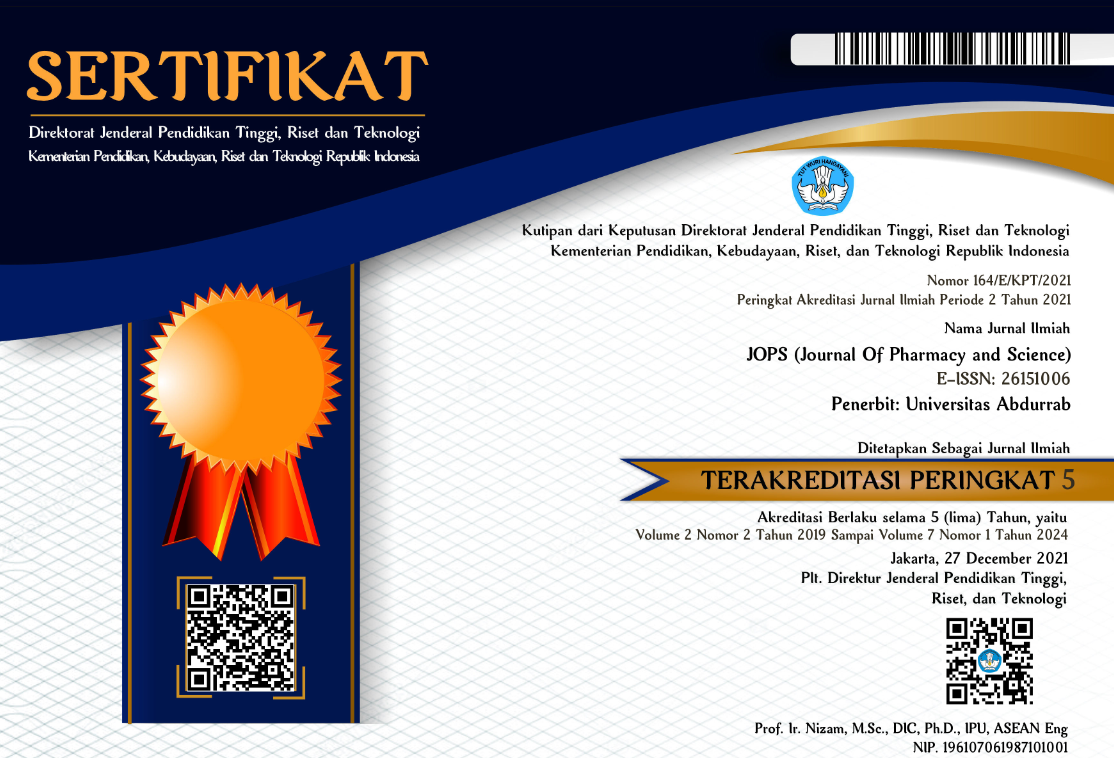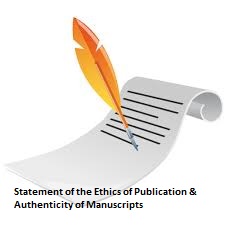Development and Validation of a Quetionnaire to Measure Patient Satisfaction with The Implementation of Telepharmacy in The Pharmacy
Abstract
Customer satisfaction surveys measure how satisfied consumers are with relevant product or service attributes and the importance of those attributes. In general, surveys use a five-point scale (Schiffman et al., 2010). Patient satisfaction can be revealed through several measuring tools. Questionnaires or assessment instruments are tools used to apply all content validity methods. The final result of content validity is an assessment of the appropriateness of the test content. Lawshe proposed a method called the content validity ratio as a result of measuring expert assessments of their agreement on content validity using statistical techniques of agreement between raters. The process of reviewing items by a panel of experts by providing input from validators is used as a reference to compose sentences that are more appropriate to the aspects and easy to understand. So to get a patient satisfaction questionnaire regarding the implementation of telepharmacy in pharmacies, some validation evidence is needed which can then produce a proper, valid questionnaire. and reliable for use in analysis of pharmacy telepharmacy patient satisfaction. To collect evidence of the validity of knowing and obtaining an instrument (questionnaire) that can be used to measure patient satisfaction with the implementation of telepharmacy services in pharmacies. Expert review (dianalisis CVI), Proses respon, Evaluasi struktur : internal struktur dengan EFA (eksplratory factor analysis) dan reliabilitas. From the SPSS results, analysis of factor loading values with Cronbach's alpha shows that the total reliability score for the expected attribute is 0.977 for factor 1, expected 0.973 and 0.926 for factor 2, expected 0.926. Meanwhile, the results of the reality reliability test, the total Cronbach's alpha score, was 0.979, with the Cronbach's alpha value for factor 1 being 0.976 and factor 2 being 0.931. From the reliability data used for each subscale it is above 0.9 so that the question statement items with Cronbach's alpha values are below 0.9 will experience elimination. A total of 10 questions were eliminated because the reliability value was below 0.9. The higher the Cronbach' alpha value, the more valid, good and reliable an item is said to be. The patient satisfaction questionnaire has sufficient evidence of validity including evidence of content validity, response process and internal structure.
References
Data Penelitian Kualitatif. Jurnal Keperawatan Indonesia 12.
Alwi, I., 2012. Kriteria Empirik dalam Menetukan Ukuran Sampel pada Pengujian Hipotesis Statistika dan
Analisis Butir. Jurnal Formatif 2.
Arikunto, S., 2016. Prosedur Penelitian Suatu Pendekatan Praktik, XIII. ed. PT. Rineka Cipta, Jakarta.
Awaludin, M., Mantik, H., Fadillah, F., 2023. Penerapan Metode SERQUAL pada Skala Likert untuk
Mendapatkan Kualitas Pelayanan Kepuasan Pelanggan. Jurnal Sistem Informasi Universitas
Suryaderma 10, 89–106.
Azwar, S., 2006. Reliabilitas dan Validitas , ketiga. ed. Pustaka Belajar, Yogyakarta.
Pratiwi et al.,
Journal of Pharmacy and Science | Vol. 7 No. 1 | Dec 2023
135
Cook, D.A., Beckman, T.J., 2006. Current Concepts in Validity and Reliability for Psychometric
Instruments: Theory and Application. Am J Med 119, 166.e7-166.e16.
https://doi.org/10.1016/j.amjmed.2005.10.036
Downing, S.M., 2003. Validity: on the meaningful interpretation of assessment data. Med Educ 37, 830–
837. https://doi.org/10.1046/j.1365-2923.2003.01594.x
Hamid, M., Sufi, I., Konadi, W., Akmal, Y., 2019. Analisis Jalur dan Aplikasi SPSS Versi 25, 1st ed. Sefa
Bumi Persada, Lhokseumawe, Aceh.
Ihsan, H., 2015. Validitas Isi Alat Ukur Penelitian: Konsep dan Panduan Penilaiannya. PEDAGOGIA Jurnal
Ilmu Pendidikan 13, 173. https://doi.org/10.17509/pedagogia.v13i3.6004
Ilma, D.L., Mustikaningtias, I., Salsabila, I.Y.N., Sholihat, N.K., Parmasari, D.H., 2023. Analisis Tingkat
Pengetahuan, Sikap dan Perilaku Apoteker Terkait Penggunaan Telefarmasi: Studi Cross-Sectional.
JPSCR: Journal of Pharmaceutical Science and Clinical Research 8, 179.
https://doi.org/10.20961/jpscr.v8i2.65680
Imaninda, V., Azwar, S., 2018. Modifikasi Patient Satisfaction Questionnaire Short Form (PSQ-18) ke
dalam Bahasa Indonesia. Gadjah Mada Journal of Psychology (GamaJoP) 2, 8.
https://doi.org/10.22146/gamajop.31864
Kowsalya, D.N., Venkat, L.H., Suresh, Dr.K.P., 2012. Development and Validation of a Scale to assess
Self-Concept in Mild Intellectually Disabled Children. international Journal Soc.Sci&Education 2.
Lambert, S.D., Loiselle, C.G., 2008. Combining individual interviews and focus groups to enhance data
richness. J Adv Nurs 62, 228–237. https://doi.org/10.1111/j.1365-2648.2007.04559.x
LYNN, M.R., 1986. Determination and Quantification Of Content Validity. Nurs Res 35, 382???386.
https://doi.org/10.1097/00006199-198611000-00017
Muljono, 2002. Penyusunan dan Pengembangan Instrumen Penelitian. Lokakarya Peningkatan Suasana
Akademik Jurusan Ekonomi (pp.1-27).
Polit, D.F., Beck, C.T., 2006. The content validity index: Are you sure you know what’s being reported?
critique and recommendations. Res Nurs Health 29, 489–497. https://doi.org/10.1002/nur.20147
Schiffman, L.G., Kanuk, L.L., Wisenblit, J., 2010. Consumer behavior, X. ed. Prentice Hall, an imprint of
Pearson Education Inc., Upper Saddle River, N.J, English.
Setiyawan, A., 2014. Faktor-Faktor yang Mempengaruhi Reliabilitas Tes. Jurnal An Nur VI, 341–354.
Sugiyono, 2013. Metode Penelitian Pendidikan: Pendekatan Kuantitatif dan kualitatif, R&D. CV. Bandung
Alfabeta. 2011, Bandung.
Suharsimi Arikunto, 2016. Prosedur Penelitian Suatu Pendekatan Praktik, 13th ed. PT. Ronerka Cipta,
Jakarta.
Wijaya, T., 2009. Analisis Data Penelitian Menggunakan SPSS, C.5. ed. Universitas Atma Jaya Yogyakarta,
Yogyakarta.
Wijayanto, A., 2008. Analisis Korelasi Product Moment Pearson. Journal data Undip.
Copyright (c) 2023 JOPS (Journal Of Pharmacy and Science)

This work is licensed under a Creative Commons Attribution-NonCommercial-ShareAlike 4.0 International License.
1. Copyright of all journal manuscripts is held by the JOPS (Journal Of Pharmacy and Science)
2. Formal legal provisions to access digital articles of electronic journal are subject to the provision of the Creative Commons Attribution-ShareAlike license (CC BY-NC-SA), which means that JOPS (Journal Of Pharmacy and Science) is rightful to keep, transfer media/format, manage in the form of databases, maintain, and publish articles.
3. Published manuscripts both printed and electronic are open access for educational, research, and library purposes. Additiponally, the editorial board is not responsible for any violations of copyright law.
licensed under a Creative Commons Attribution-ShareAlike 4.0 International License.
 PDF (Bahasa Indonesia)
PDF (Bahasa Indonesia)
 Abstract views: 122
Abstract views: 122
 downloads: 119
downloads: 119

 :
:
1.png)








